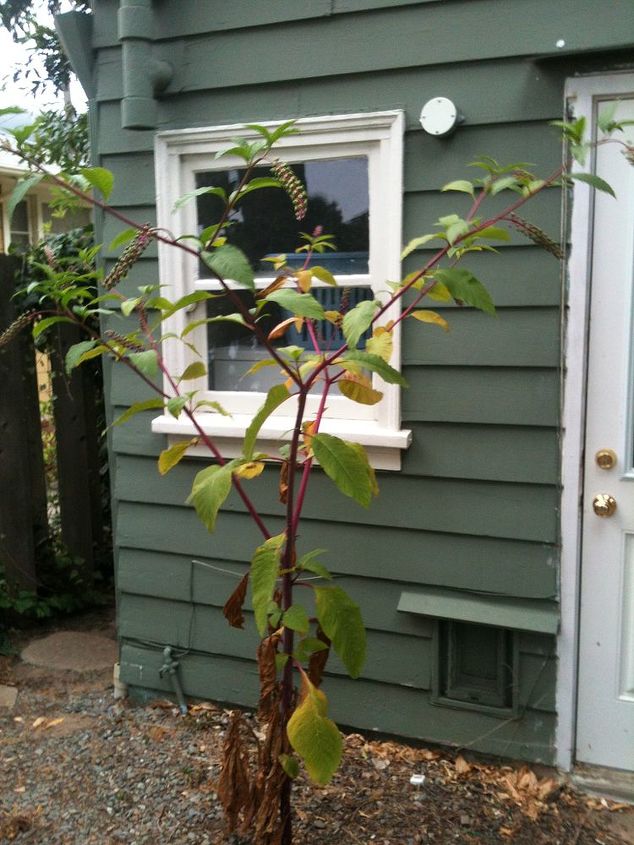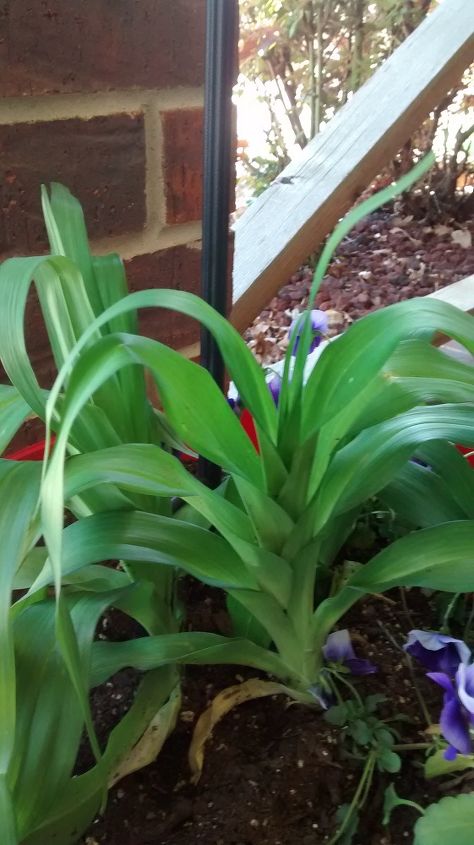Can you identify this plant for me?

-
It is Pokeweed (Phytolacca americana) and the berries are great food for birds, BUT the birds poop the seeds everywhere! They are very invasive in a landscape. They not only reseed prolifically, but they are perennial. If you chop it down, it will come back from the roots. They must be dug up or killed with a systemic herbicide (like Roundup) that kills the roots.
 Katie Price
on Sep 10, 2014
Helpful Reply
Katie Price
on Sep 10, 2014
Helpful Reply- See 4 previous
-
-
The pokeweed in the south can reach about 7-8' tall! the seeds will last for years in the ground too so you will pulling new shoots. As Katies says they are invasive but great brid food. and the purple will stain anything and everything! pulling them up is fairly easy when they are small but just use a shovel and dig under and lift the plant out. good luck on eradicating this beast. lol
 The Garden Frog with C Renee
on Sep 10, 2014
Helpful Reply
The Garden Frog with C Renee
on Sep 10, 2014
Helpful Reply- See 1 previous
-
-
According to the California Invasive Plant Council it's found throughout most of the state: http://www.cal-ipc.org/ip/management/plant_profiles/Phytolacca_americana.php
 Douglas Hunt
on Sep 11, 2014
Helpful Reply
Douglas Hunt
on Sep 11, 2014
Helpful Reply -
-
People in the rural South used to (maybe still do) eat 'poke salad' made from the new tender shoots of the Pokeweed plant. Mature foliage is toxic, but apparently the new growth is safe. I'll pass, none the less.
 Katie Price
on Sep 15, 2014
Helpful Reply
Katie Price
on Sep 15, 2014
Helpful Reply -
-
No consensus???? Here is part of just one article I Googled, " It's not just the bees that are dying. Butterfly and bird populations are in decline, too. And it's not just the neonicotinoids that are to blame. Other herbicides and pesticides, especially Monsanto's Roundup, used to grow GMO crops-and also used to contain (kill) weeds in cities and home gardens-are decimating pollinators, fish and wildlife, and some would argue, humans, to.................." There are many, many more. If scientists do not agree, why have the Brits, Europe and India for example ALL banned it?
 Linda T
on Sep 16, 2014
Helpful Reply
Linda T
on Sep 16, 2014
Helpful Reply -
-
From the Ntional Geographic. "Another adversary in the bees' battle, as the EU reminds us, is pesticides. Pesticides themselves aren't necessarily a death sentence for bees—and debate rages over whether, when properly applied, these chemicals can be used safely among pollinators. But exposure to them seems to open the door to other killers. For example, bees exposed to sublethal doses of neonicotinoids—the type the EU is banning and that are used routinely in the U.S. on wheat, corn, soy, and cotton crops—become more easily infected by the gut parasite Nosema. Meanwhile, last year a French study indicated that this same class of chemicals can fog honeybee brains and alter behavior. And a British study on bumblebees, a natural pollinator in decline in many places, reported neonicotinoids keep bees from supplying their hives with enough food for queen production." The reason Roundup is still used recklessly here, is the Loch Brothers and their hold on so many huge corporations who lobby the politicians not to ban these poisons! (Which is now found in mothers' milk BTW!)
 Linda T
on Sep 16, 2014
Helpful Reply
Linda T
on Sep 16, 2014
Helpful Reply -
-
Pokeweed. The seeds were used by native people for a purple ink/dye. The plant is toxic but can be prepared by boiling with multiple changes of water (3 seems to be the recommended number of water changes) and is similar to spinach and other greens to eat. The flower racemes are pretty (small white flowers) and the magenta stalks are colorful. A weed in most areas and considered invasive in many states. Perennial.
 Dorothy
on Oct 04, 2014
Helpful Reply
Dorothy
on Oct 04, 2014
Helpful Reply -
-
Early settlers used the berries to dye yarns
 Diana.Davenport
on Jan 31, 2015
Helpful Reply
Diana.Davenport
on Jan 31, 2015
Helpful Reply -
-
Yep, It's poke sallet. And I love it! It's almost springtime in Tennessee and I'll be out looking for it. It's like a 'spring tonic' to me. Gets the digestive organs moving along smoothly and helps clean out the liver and blood (so I'm told). I have used the berries to dye wooden projects and yarn/fabric. The thicker stems can be stripped of the thin outer bark and cut up and fried just like okra - another Southern favourite. The berries are poisonous and eating the plant raw is poisonous. Don't know that it will kill you dead, but it will make you ill. I'll fix and eat it every chance I get! Send it to me - haha!
 Francisco37388
on Feb 04, 2015
Helpful Reply
Francisco37388
on Feb 04, 2015
Helpful Reply -
Related Discussions
GNATS - How to get rid of them?
Somehow my house and garden got tiny gnats that killed my fuchsia plant and fly everywhere. I have tried ALL the Web recommendations - soap and oil dishes, sand in th... See more
Marigolds growing! Should I pinch the buds?
My marigold plants are growing. I heard that pinching the buds until Autumn will allow them to grow without killing the plant. Is this true?
Growing garlic
Growing our first garlic, should we wait until the leaves are drying out before we pick it? Husband picked first one today along with our first potatoes.
How to keep mice out of your garden?
Hi everyone, I have mice in my garden destroying my vegetables and I have also noticed them in the barn and shed. Please can someone tell me how to prevent them from ... See more
What's the best flower/plant to grow in Texas?
I know that opinions vary, but what's your opinion?!I have great luck w Rosemary plants. Green all year long.
Help me identify this plant
This plant came from an old flower bed at my sisters. We dug them up when they were small. She thought she had lillies in that bed. But this doesn't look like anythin... See more
Can you help me identify this bush?
I have a bush that has leaves similar to a chrysanthemum but it has thorns. Don't know if it's a plant or a weed! It was here when we moved in last summer.





